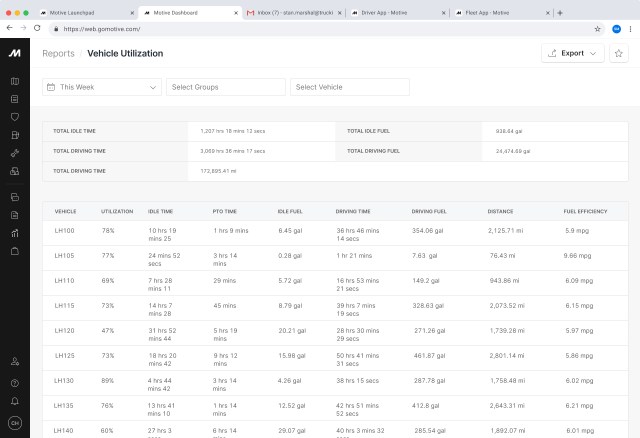It’s an uncertain time for many of America’s fleets. Many of our customers are looking for ways to reduce operating expenses. At Motive, we’re dedicated to getting you through this.
Here are some of the ways we’re working with our customers to reduce operating costs with Motive:
Note: If you need help using any of the features or reports covered in this article, call us at (855) 434-3564 or reach out to your Customer Success Manager.
5 ways to reduce fleet operating expenses
1. Prevent breakdowns with vehicle diagnostics
Taking vehicles into the shop for preventative maintenance checks is expensive for fleets, as is experiencing unexpected breakdowns. Especially in an environment where many loads are so time-sensitive.
Some of the costs to consider are:
- A tow truck
- External mechanic labor and parts
- Lost on-time bonuses
- Non-revenue generating downtime
By monitoring vehicle diagnostics in Motive, you can identify and receive real-time alerts for small vehicle issues immediately and resolve them before a costly breakdown occurs.

You can also set up automated maintenance reminders based on mileage, usage, and time, depending on the type of vehicle or asset.

With this information, you can ensure vehicles are serviced on time and avoid unnecessary breakdowns and part failures.
Being proactive with maintenance today can save thousands tomorrow.
2. Reduce your accident risk
The country is depending on drivers, and they are stepping up to the task heroically. The suspension of Hours of Service rules for certain cargo types provides them the flexibility to get the job done. But, it’s possible some will push themselves too far out of a sense of duty.
Studies show that when drivers get tired, critical events increase. This is primarily due to delayed reaction time. A high number of critical events is often associated with future accident risk.
Driver’s safety is by far the top concern here, and there are financial risks as well. The average accident costs $91,000, and that number rises to $200,000 if there’s an injury. There are also likely future insurance premium increases.
By using Motive’s Driver Safety Scorecards, you can identify the drivers who have experienced a high number of recent critical events.

Monitoring this information can help you understand when to intervene and ensure your driver gets the rest they need.
3. Identify underutilized vehicles and assets
Some fleets have vehicles and assets that are underutilized. Motive utilization reports measure any vehicle or asset (If you have a Motive Asset Gateway) that’s used within any time period.

With this information, you can identify the vehicles and assets that can be sold without significantly impacting your business.
4. Simplify IFTA filing
IFTA reporting can be a time consuming task for fleets. Some fleets spend two days per month working on IFTA reports, and others pay professionals to prepare IFTA reports.
Don’t worry about losing time with Motive, which automates much of the IFTA filing process, and saves you time and money. That’s a big win for reducing your operating expenses.

The best part? Motive tracks miles per jurisdiction by default – even if you didn’t have Motive Pro for the entire period. This article walks through filing IFTA with Motive in detail.
5. Minimize fuel usage
Did you know that trucks burn about one gallon of fuel for every hour of idle time? Or that idling for 1 hour per day for a year is the equivalent of 64,000 miles of engine wear?
You can use Motive utilization reports to identify and address excessive idling.

Our customers often address idling by offering a bonus for low idling rates, making it a financial win-win.
Additionally, aggressive driving behavior reduces fuel efficiency by 20-30%. By coaching drivers to reduce their number of critical events, you can save even more on fuel.
Lower your fleet operating expenses with Motive
The best way to prepare for an uncertain future is to optimize your operations today. The Motive team is here to help you increase the efficiency of your business. If you would like any assistance or advice on using any of the features or reports covered in this article, call us at (855) 434-3564 or reach out to your Customer Success Manager.




